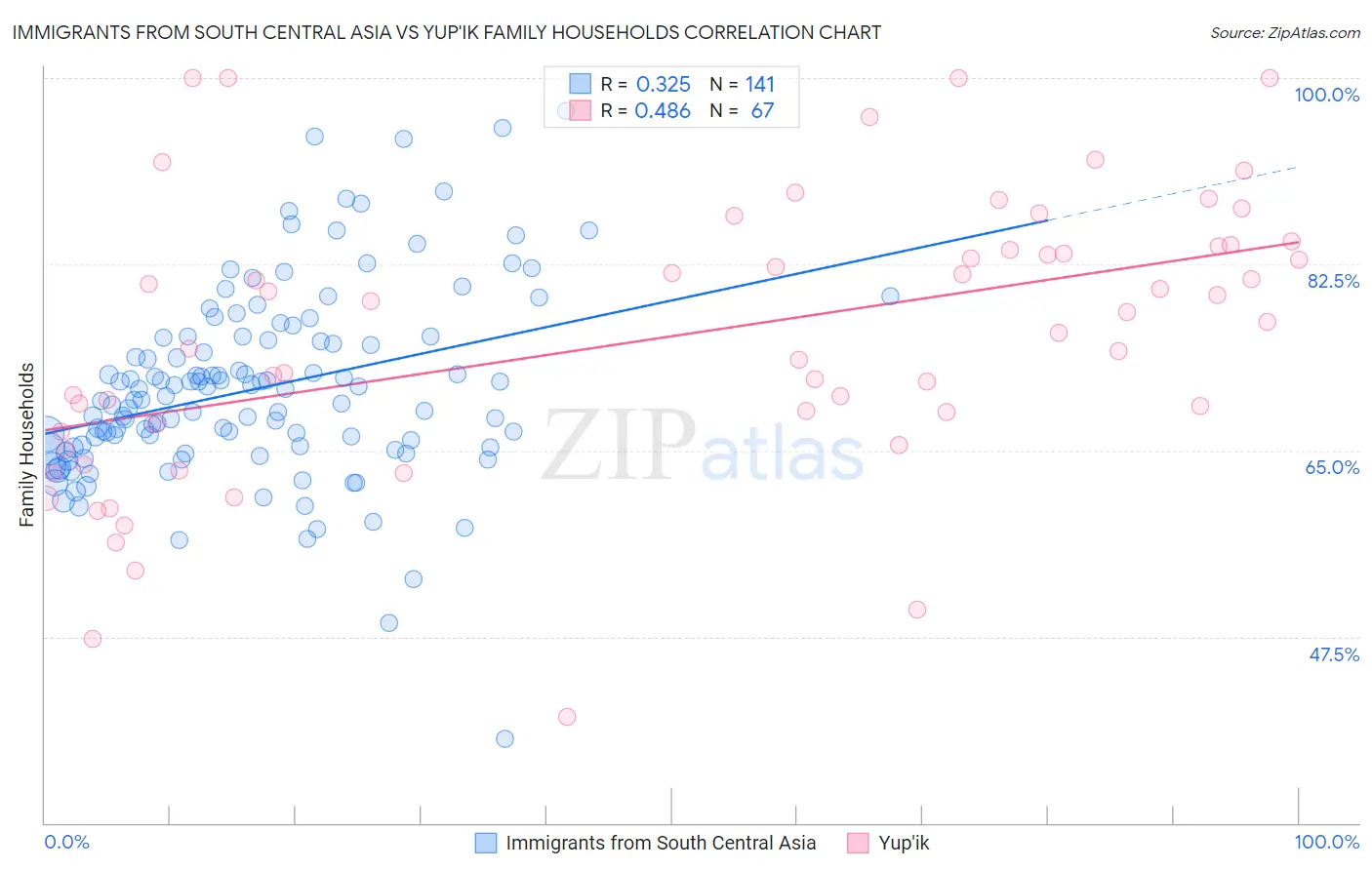Immigrants from South Central Asia vs Yup'ik Family Households
COMPARE
Immigrants from South Central Asia
Yup'ik
Family Households
Family Households Comparison
Immigrants from South Central Asia
Yup'ik
66.4%
FAMILY HOUSEHOLDS
100.0/ 100
METRIC RATING
49th/ 347
METRIC RANK
72.4%
FAMILY HOUSEHOLDS
100/ 100
METRIC RATING
1st/ 347
METRIC RANK
Immigrants from South Central Asia vs Yup'ik Family Households Correlation Chart
The statistical analysis conducted on geographies consisting of 472,677,474 people shows a mild positive correlation between the proportion of Immigrants from South Central Asia and percentage of family households in the United States with a correlation coefficient (R) of 0.325 and weighted average of 66.4%. Similarly, the statistical analysis conducted on geographies consisting of 39,956,676 people shows a moderate positive correlation between the proportion of Yup'ik and percentage of family households in the United States with a correlation coefficient (R) of 0.486 and weighted average of 72.4%, a difference of 9.0%.

Family Households Correlation Summary
| Measurement | Immigrants from South Central Asia | Yup'ik |
| Minimum | 37.9% | 40.0% |
| Maximum | 97.0% | 100.0% |
| Range | 59.0% | 60.0% |
| Mean | 70.8% | 75.6% |
| Median | 69.8% | 77.1% |
| Interquartile 25% (IQ1) | 65.3% | 66.8% |
| Interquartile 75% (IQ3) | 75.5% | 84.2% |
| Interquartile Range (IQR) | 10.2% | 17.4% |
| Standard Deviation (Sample) | 9.0% | 13.2% |
| Standard Deviation (Population) | 9.0% | 13.1% |
Similar Demographics by Family Households
Demographics Similar to Immigrants from South Central Asia by Family Households
In terms of family households, the demographic groups most similar to Immigrants from South Central Asia are Immigrants from Venezuela (66.4%, a difference of 0.050%), Bolivian (66.5%, a difference of 0.070%), Navajo (66.4%, a difference of 0.070%), Native/Alaskan (66.4%, a difference of 0.090%), and Arapaho (66.5%, a difference of 0.10%).
| Demographics | Rating | Rank | Family Households |
| Menominee | 100.0 /100 | #42 | Exceptional 66.5% |
| Apache | 100.0 /100 | #43 | Exceptional 66.5% |
| Asians | 100.0 /100 | #44 | Exceptional 66.5% |
| Venezuelans | 100.0 /100 | #45 | Exceptional 66.5% |
| Arapaho | 100.0 /100 | #46 | Exceptional 66.5% |
| Bolivians | 100.0 /100 | #47 | Exceptional 66.5% |
| Immigrants | Venezuela | 100.0 /100 | #48 | Exceptional 66.4% |
| Immigrants | South Central Asia | 100.0 /100 | #49 | Exceptional 66.4% |
| Navajo | 100.0 /100 | #50 | Exceptional 66.4% |
| Natives/Alaskans | 100.0 /100 | #51 | Exceptional 66.4% |
| Colombians | 100.0 /100 | #52 | Exceptional 66.3% |
| Afghans | 100.0 /100 | #53 | Exceptional 66.3% |
| Immigrants | Colombia | 100.0 /100 | #54 | Exceptional 66.3% |
| Immigrants | Immigrants | 100.0 /100 | #55 | Exceptional 66.1% |
| Immigrants | Hong Kong | 100.0 /100 | #56 | Exceptional 66.1% |
Demographics Similar to Yup'ik by Family Households
In terms of family households, the demographic groups most similar to Yup'ik are Spanish American Indian (71.2%, a difference of 1.8%), Tongan (69.6%, a difference of 4.0%), Yakama (69.3%, a difference of 4.5%), Yuman (69.3%, a difference of 4.5%), and Immigrants from Mexico (69.1%, a difference of 4.8%).
| Demographics | Rating | Rank | Family Households |
| Yup'ik | 100 /100 | #1 | Exceptional 72.4% |
| Spanish American Indians | 100.0 /100 | #2 | Exceptional 71.2% |
| Tongans | 100.0 /100 | #3 | Exceptional 69.6% |
| Yakama | 100.0 /100 | #4 | Exceptional 69.3% |
| Yuman | 100.0 /100 | #5 | Exceptional 69.3% |
| Immigrants | Mexico | 100.0 /100 | #6 | Exceptional 69.1% |
| Mexicans | 100.0 /100 | #7 | Exceptional 69.0% |
| Immigrants | Fiji | 100.0 /100 | #8 | Exceptional 68.8% |
| Native Hawaiians | 100.0 /100 | #9 | Exceptional 68.4% |
| Immigrants | Philippines | 100.0 /100 | #10 | Exceptional 68.3% |
| Immigrants | Central America | 100.0 /100 | #11 | Exceptional 68.3% |
| Koreans | 100.0 /100 | #12 | Exceptional 68.3% |
| Pueblo | 100.0 /100 | #13 | Exceptional 68.2% |
| Immigrants | Cuba | 100.0 /100 | #14 | Exceptional 68.2% |
| Assyrians/Chaldeans/Syriacs | 100.0 /100 | #15 | Exceptional 68.2% |